Raspberry Pi BME280 MySQL Data Collection
- Introduction
- Setting Up the Raspberry Pi
- Installing Necessary Packages and Libraries
- Wiring Raspberry Pi and BME280
- Python Code
Introduction
This tutorial will use a Raspberry Pi Zero W, a BME280 sensor, and MariaDB in order to collect temperature, pressure, and humidity data and store it in a DBMS. The Python code can be downloaded from my GitHub page.
Setting Up the Raspberry Pi
The first step for this project is to install the Raspbian Stretch OS for the Raspberry Pi. Download the Raspbian Stretch OS image from the Raspberry Pi website and flash it to your MicroSD card using Etcher as seen in their tutorial. Once the process has been completed, insert the MicroSD card into your Raspberry Pi and install the OS (it should install automatically). You will now be greeted with the Raspbian Stretch OS desktop. Go to Raspberry Pi Configuration by selecting the menu in the top left corner of the screen. Select the Interfaces tab and enable SSH and I2C. Also set up your Wi-Fi in the top right corner.

Settings

Interfaces and Wi-Fi
Open up the terminal and type in the command sudo ifconfig in order to locate your local IP address which will be used to connect to the Raspberry Pi remotely using PuTTY.
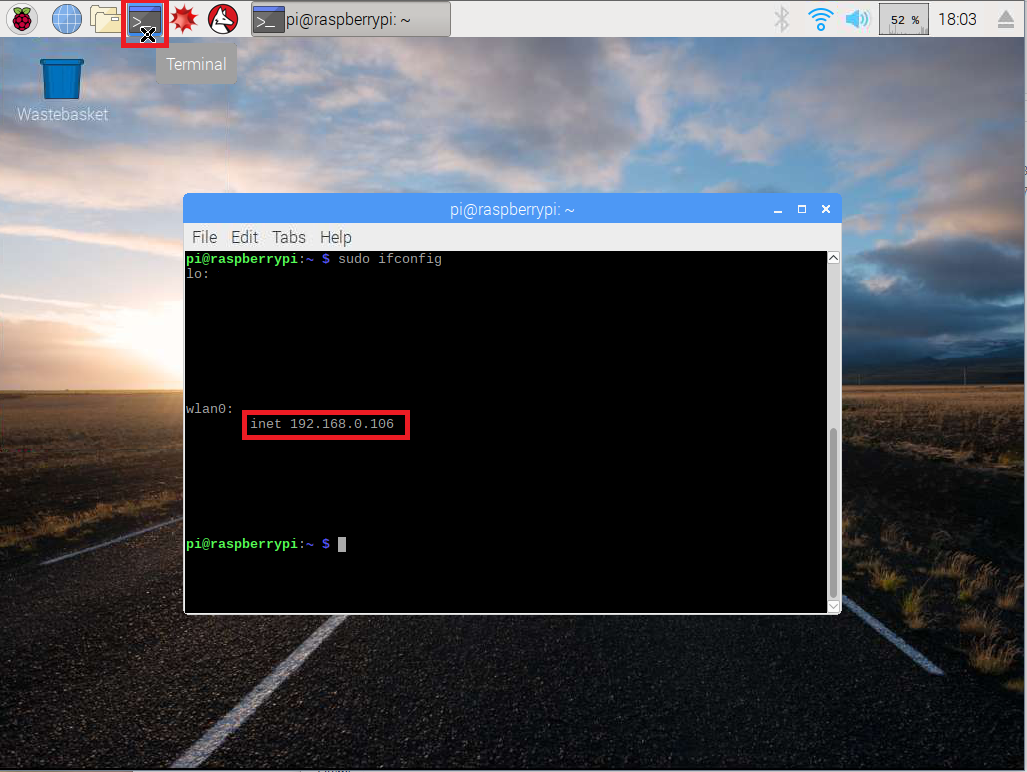
Local IP Address
Now open up PuTTY and enter your Raspberry Pi's IP Address in the Host Name box. The default user is pi and default password is raspberry. You can now start installing the necessary packages and libraries for this tutorial.
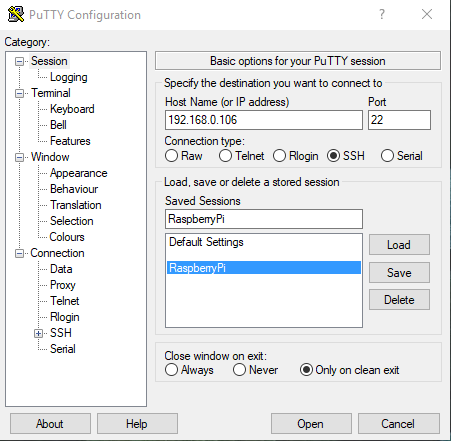
PuTTY
Installing Necessary Packages and Libraries
The first set of packages and libraries that need to be installed include the Adafruit Python GPIO Library which allows the Raspberry Pi to interact with the sensor. The necessary packages and libraries can be installed with the commands below as stated in the Adafruit Python GPIO Library GitHub page.
sudo apt-get update
sudo apt-get install build-essential python-pip python-dev python-smbus git
git clone https://github.com/adafruit/Adafruit_Python_GPIO.git
cd Adafruit_Python_GPIO
sudo python setup.py install
Move one directory up with cd .. and clone the Adafruit_Python_BME280 files with the command below. More information on some basic Linux commands can be seen in the Linux Tutorial page.
git clone https://github.com/adafruit/Adafruit_Python_BME280.git
Install MySQL with sudo apt-get install mysql-server as seen in the MySQL Tutorial page. Raspberry Pi will install MariaDB instead but the SQL commands that worked for MySQL will work with MariaDB. You can log in to MariaDB with sudo mysql -u root. Now create a database and table in MariaDB in order to enter the BME280 data. I have created a database named RaspberryPi and a table named BME280_Data with the columns date_time, temperature, pressure, and humidity. More information on creating databases and tables using SQL can be seen in the MySQL Tutorial page. Also create a new user with the CREATE USER command below where newuser is the username of the new user and newuserpassword is the password of the new user. Grant all privileges for the user. More information on privileges can be seen here. You can exit MariaDB by typing exit in the terminal.
sudo mysql -u root
CREATE DATABASE RaspberryPi;
USE RaspberryPi;
CREATE TABLE BME280_Data (date_time VARCHAR(50), temperature FLOAT, pressure FLOAT, humidity FLOAT);
DESCRIBE BME280_Data;
CREATE USER 'newuser'@'localhost' IDENTIFIED BY 'newuserpassword';
GRANT ALL PRIVILEGES ON *.* TO 'newuser'@'localhost';
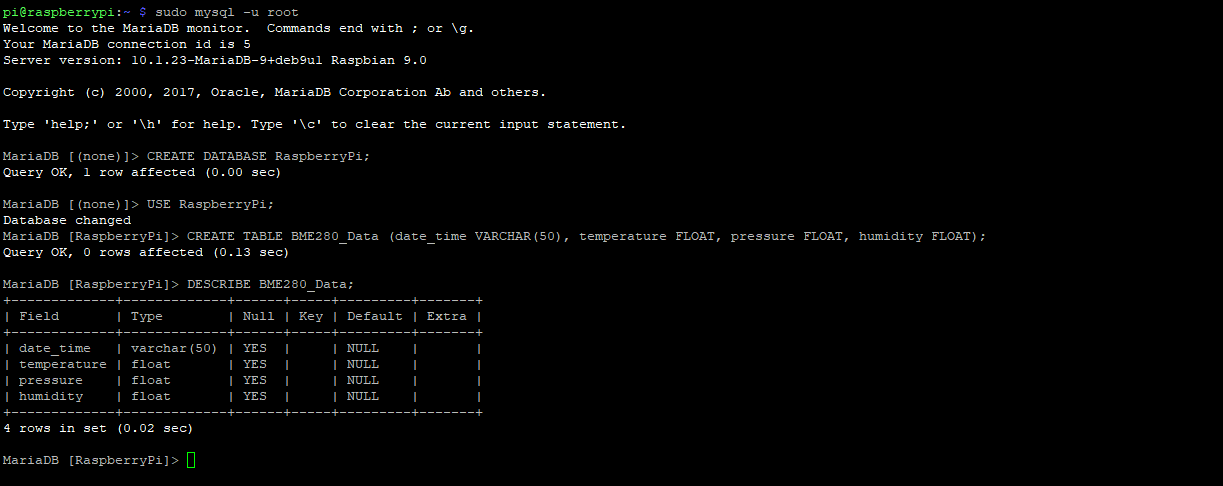
MariaDB
Now install the Python MySQL package MySQLdb in order for Python to be able to communicate with MySQL/MariaDB.
sudo apt-get install python-mysqldb
Install the vim editor to easily edit files later on.
sudo apt-get install vim
Wiring Raspberry Pi and BME280
The wiring for the BME280 sensor and the Raspberry Pi is seen in the diagram below. This diagram was created using Fritzing. The pinout diagram for the Raspberry Pi is from pinout.xyz. The wires are connected as follows:
BME280 -----> Raspberry Pi
-------------------------------------
VIN -----> Pin 2 or 4 (5V Power)
GND -----> Pin 6 (Ground)
SCK/SCL -----> Pin 5 (SCL)
SDI/SDA -----> Pin 3 (SDA)

Raspberry Pi and BME280 Diagram

Raspberry Pi Zero Pinout Diagram from pinout.xyz
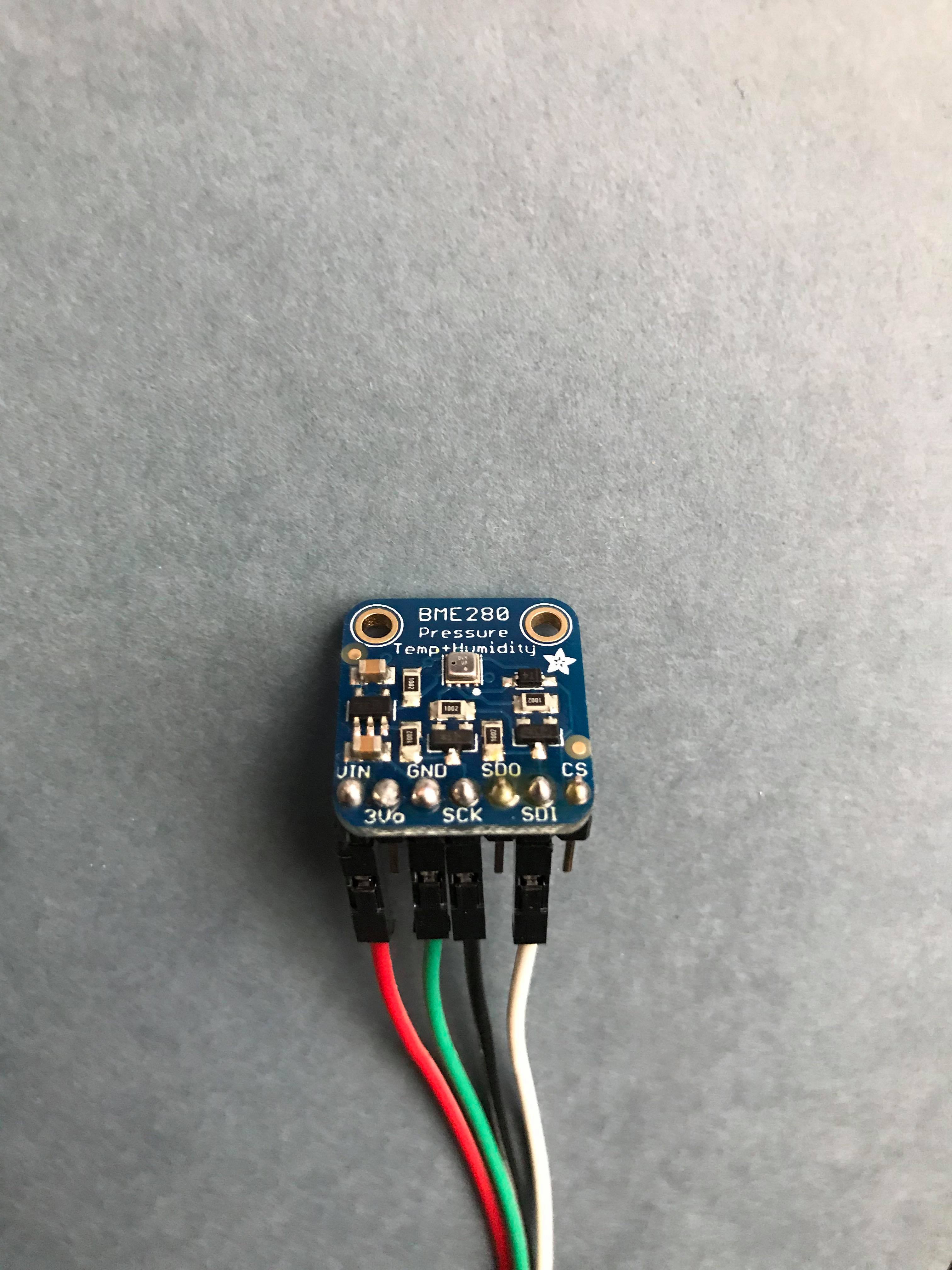
BME 280
Raspberry Pi Connected
Type the command sudo i2cdetect -y 1 in the terminal and you should be able to see the output below if everything is connected correctly.

i2cdetect
You can run the Adafruit_BME280_Example.py script in order to see the BME280 sensor data at the time at which the aforementioned script was executed.
python Adafruit_BME280_Example.py

Adafruit_BME280_Example.py
Python Code
Go to the Adafruit_Python_BME280 directory and copy the Adafruit_BME280_Example.py script using cp Adafruit_BME280_Example.py BME280_Custom.py. Also create a file named BME280CSV with touch BME280CSV in order to save data to a CSV file which can also be done with the Raspberry Pi. Open up the BME280_Custom.py file with the vi editor using vi BME280_Custom.py. You should now see the unedited copy of Adafruit_BME280_Example.py. We will modify the original file in order for the BME280 sensor to continuously collect data and add it to the BME280_Data table created earlier in MariaDB.

Original Adafruit_BME280_Example.py
The modified Python script for the BME280 sensor can be seen below. The MySQLdb module allows one to connect to the MySQL/MariaDB DBMS and run queries through the cursor execute option. The module csv allows easy editing of csv files. The datetime module states the current date time when the data is collected inside the while True: loop. The module time allows the data collection while True: loop to pause for 60 seconds with time.sleep(60) before it collects data again. More specific details about the code are comments within the code.
from Adafruit_BME280 import *
import time
import datetime
import csv
import MySQLdb
db = MySQLdb.connect(host="localhost",user="newuser", passwd="newuserpassword",db="RaspberryPi") #connects to MySQL/MariaDB
cur = db.cursor() #creates cursor to pass on demands to MySQL/MariaDB
sensor = BME280(t_mode=BME280_OSAMPLE_8, p_mode=BME280_OSAMPLE_8, h_mode=BME280_OSAMPLE_8)
with open(r'BME280CSV','w') as f: #w means write to file
writer = csv.writer(f)
writer.writerow(['Date Time (YYYY-MM-DD HH:MM:SS','Temperature (deg C)','Pressure (Pa)','Humidity (%)']) #CSV file headers
while True: #collects data indefinitely
degrees = sensor.read_temperature()
pascals = sensor.read_pressure()
hectopascals = pascals / 100
humidity = sensor.read_humidity()
timenow = datetime.datetime.utcnow()
#executes the SQL command in MySQL/MariaDB to insert data.
cur.execute('''INSERT INTO BME280_Data(date_time, temperature, pressure, humidity) VALUES(%s,%s,%s,%s);''',(timenow,degrees,pascals,humidity))
db.commit() #commits the data entered above to the table
# print 'Time = ' + str(timenow)
# print 'Temp = {0:0.3f} deg C'.format(degrees)
# print 'Pressure = {0:0.2f} hPa'.format(hectopascals)
# print 'Humidity = {0:0.2f} %'.format(humidity)
with open(r'BME280CSV', 'a') as f: #a means append to file
writer = csv.writer(f)
writer.writerow([timenow,degrees,pascals,humidity])
time.sleep(60) #waits for 60 seconds to collect data again
You can run the BME280_Custom.py script with the command below. The addition of & allows the script to run in the background so one can resume working on other things since this script goes on indefinitely due to while True:.
python BME280_Custom.py &
Open up BME280CSV with vi BME280CSV and you should see the CSV file populated.
vi BME280CSV

BME280CSV
You can also see the data being added to the table we created earlier in MySQL/MariaDB.
SELECT * FROM BME280_Data;
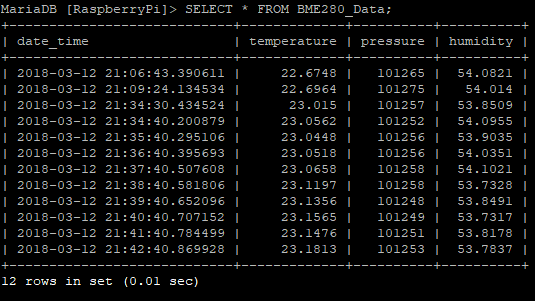
MySQL/MariaDB Data
Now copy the BME280_Custom.py script and name the new file BME280_Extract.py with cp BME280_Custom.py BME280_Extract.py. This file will be used to pull data from MySQL/MariaDB. Also create a new file named BME280CSVNEW with touch BME280CSVNEW in order to save the data from the query. The modified file for the BME280 sensor can be seen below along with some comments.
import csv
import MySQLdb
db = MySQLdb.connect(host="localhost",user="newuser", passwd="newuserpassword",db="RaspberryPi") #connects to MySQL/MariaDB
cur = db.cursor() #creates cursor to pass on demands to MySQL/MariaDB
with open(r'BME280CSVNEW','w') as f: #w means write to file
writer = csv.writer(f)
writer.writerow(['Date Time (YYYY-MM-DD HH:MM:SS','Temperature (deg C)','Pressure (Pa)','Humidity (%)']) #CSV file headers
#executes the SQL command in MySQL/MariaDB to collect data.
cur.execute('''SELECT * FROM BME280_Data''')
for row in cur.fetchall(): #prints all rows
print row #this prints a row in all columns
# print row[0] #this prints a row in a specific column
with open(r'BME280CSVNEW', 'a') as f: #a means append to file
writer = csv.writer(f)
writer.writerow([row])
db.close()
Run the new Python script with python BME280_Extract.py. Note that there is no & since this script does not run indefinitely as it doesn't contain the while True: statement. You can also view the new CSV file with vi BME280CSVNEW.
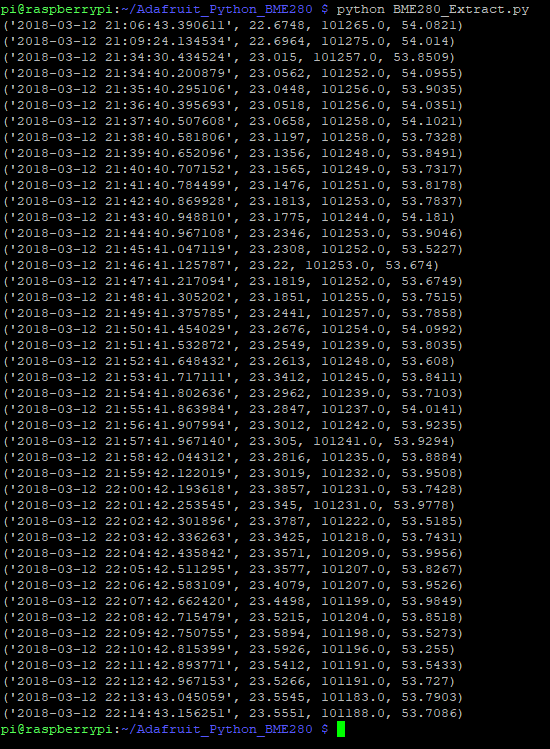
python BME280_Extract.py
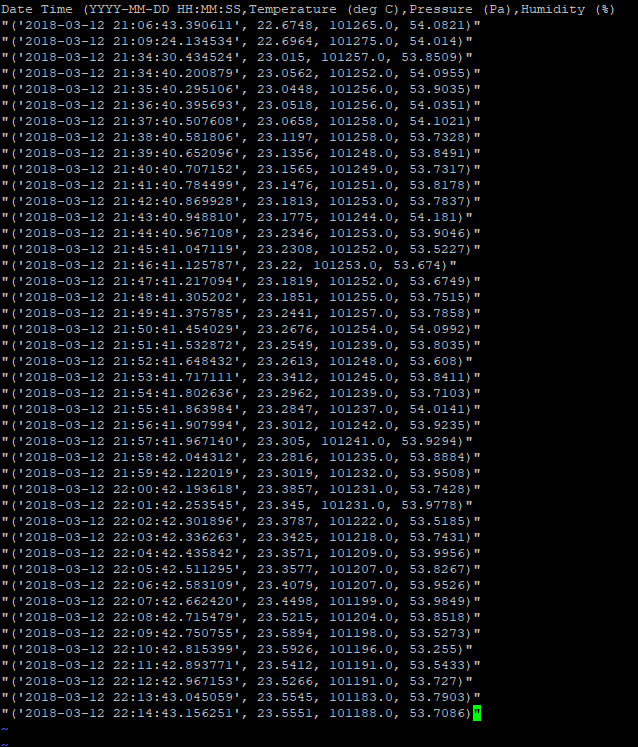
vi BME280CSVNEW